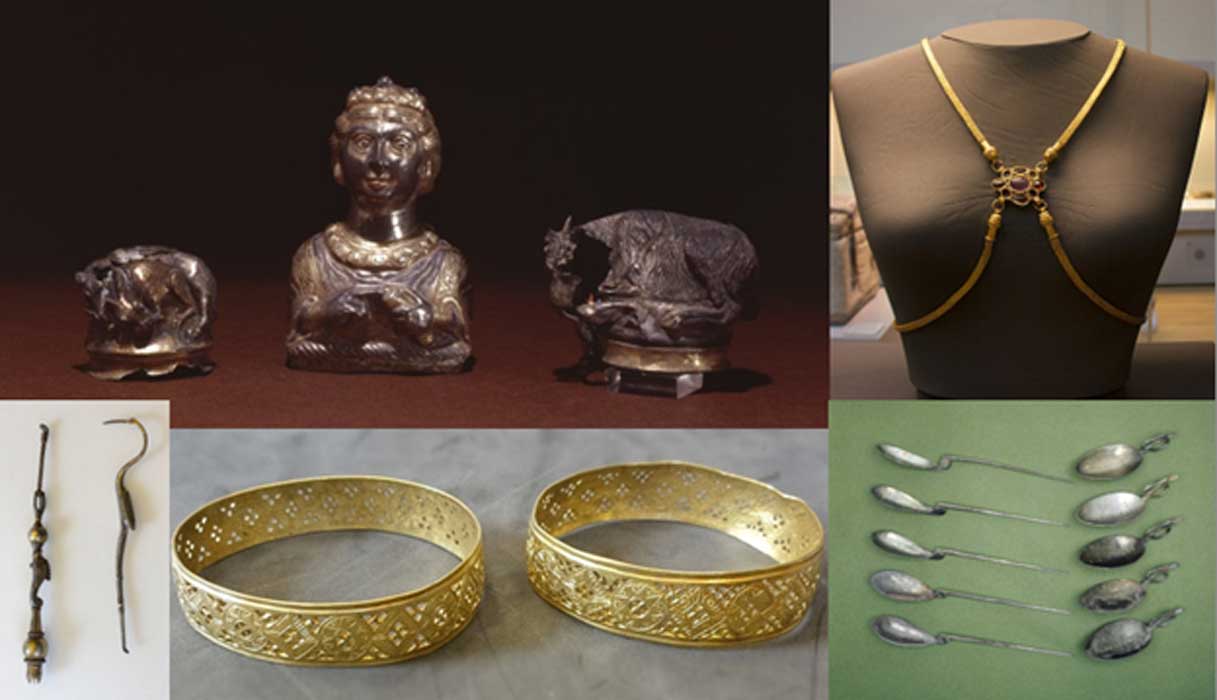The Hoxne Hoard: How a Mislaid Hammer Led to the Largest Roman Treasure in Britain
The Hoxne Hoard is a huge treasure from the late Roman period. To date, this is the largest hoard of late Roman gold and silver that has been found in the UK, and indeed, anywhere in the Roman world. The Hoxne Hoard consists of over 15,000 objects, mostly coins.
Other impressive artifacts in this spectacular hoard include jewelry, and an assortment of tableware. The most important pieces, as well as a selection of the best of the rest are now on permanent display in the British Museum in London.
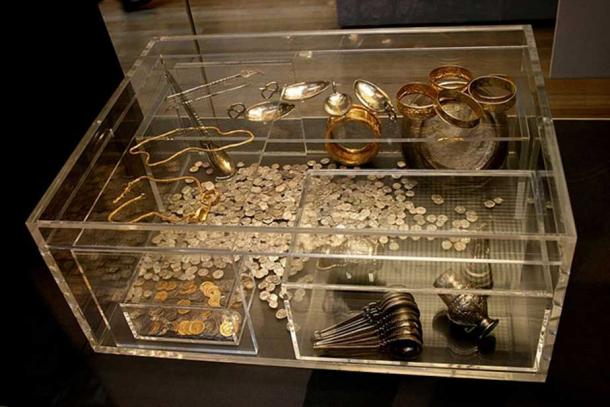
Hoxne Hoard: Display case at the British Museum showing a reconstruction of the arrangement of the hoard treasure when excavated in 1992. (Mike Peel/CC BY SA 4.0)
Finding the Hoxne Hoard Location
The story of the Hoxne Hoard’s discovery begins with a lost hammer. On November 16, 1992, a man by the name of Eric Lawes was helping out a local farmer in Hoxne village, Suffolk. The farmer had lost his hammer in a field, and Lawes, who received a metal detector as a retirement gift, was called to help find it. When the detector picked up a strong signal in the earth, Lawes started digging, which resulted in two carrier bags being filled with coins and silver spoons. At that point, Lawes stopped, and contacted the landowner, the police, and the Suffolk Archaeological Society to report the discovery.
- Finders of Killingholme Treasure Hoard Make a Mint
- The Eberswalde Hoard: Golden Treasure Trove of the Bronze Age
- Bronze Treasures Beyond Belief: The Fabulous Dowris Hoard of Ireland
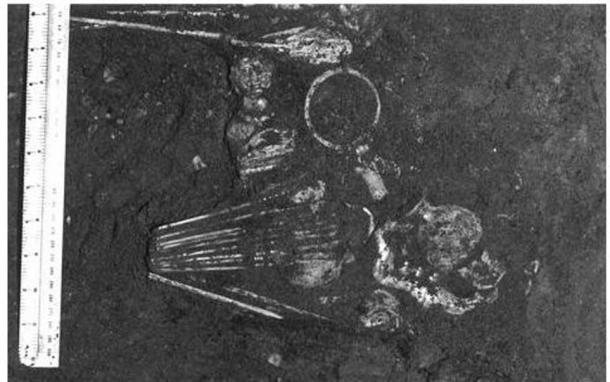
Some of the artifacts from the collection still in the ground. (hoxne.net)
The next day, a team from the Suffolk County Council Archaeology Service arrived at the spot where Lawes had made his discovery. Led by Jude Plouvier, the archaeologists were able to excavate the remaining pieces with more care. A chunk of earth containing the remaining treasure was removed from the site so that the objects within could be carefully removed under laboratory conditions. This allowed the age and the best storage method for the treasure to be determined.
At the end of this process, the archaeologists had a mass of gold and silver artifacts weighing about 27 kg (60 lbs.) This included slightly over 15,000 Roman coins, dozens of silver spoons, and various gold objects. Incidentally, the hammer was also found, and is now part of the British Museum’s collection as well.

The hammer that led to the discovery of the huge Roman hoard. (CC BY NC SA 4.0)
A Lost Hope in Hoarding
Based on the coins found within the hoard, archaeologists have estimated that the Hoxne Hoard was buried no later than 450 AD. Towards the end of the 4th century AD, the western part of the Roman Empire was in turmoil. In order to defend their territory in mainland Europe from invading barbarians, the Romans removed their troops from Britain. Without Roman protection, Britain was now vulnerable to raids from barbarians such as the Saxons, Anglos, and Picts. As a result, the Romano-British citizens of the island began to hoard their valuables, in the hopes that once the chaos had passed, they could return to collect them.

Silver coin from the treasure. Workshop sample. Inscribed with "D N VALENS P F AVG" (Our Lord Valens Pious Fortunate Augustus). Minted in Siscia. (Fæ/CC BY SA 3.0)
The fact that hoards have been discovered today is proof enough that their owners somehow never got back to them. Whilst many of the hoards contain only coins, the Hoxne Hoard is rather unique as it contains other valuable objects as well. For instance, one of the best known objects in the treasure is the so-called ‘Empress’ pepper pot. This object is a silver pepper pot in the form of a noble woman. A great deal of attention was paid to the details of the figure when the pot was being made, and features such as the woman’s hairstyle, her clothes, and her jewelry are depicted.
- Treasures Found Within Very Valuable Viking Hoard Finally Revealed
- Amazing Find with a Metal Detector - The Incredible Staffordshire Anglo-Saxon Gold Hoard
- Metal Detectorist’s Roman Hoard Linked to a Temple that Likely Inspired The Lord of the Rings
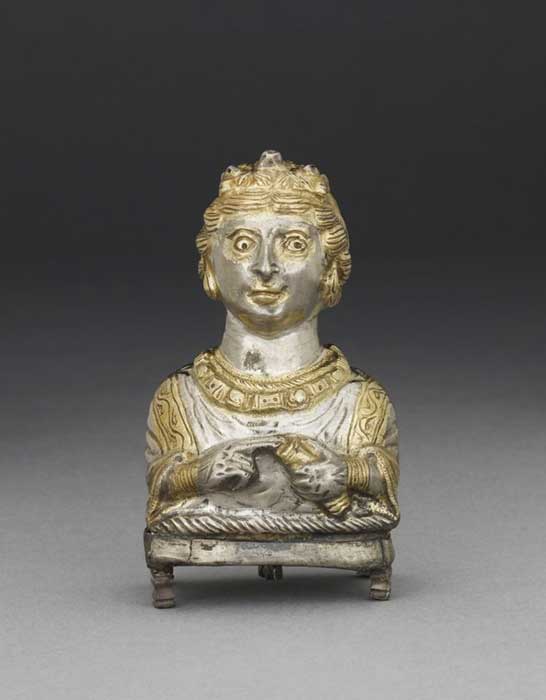
The Hoxne 'Empress' pepper pot. (CC BY NC SA 4.0)
Who Owned the Hoard?
Some of the items in the Hoxne Hoard are quite personal, and may be an indication of its owners. For instance, there is a gold bracelet with the inscription ‘UTERE FELIX DOMINA IULIANE’, which may be translated to mean ‘Use this happily Lady Juliane’, whilst another name, ‘Aurelius Ursicinus’, has been found on several of the other objects.
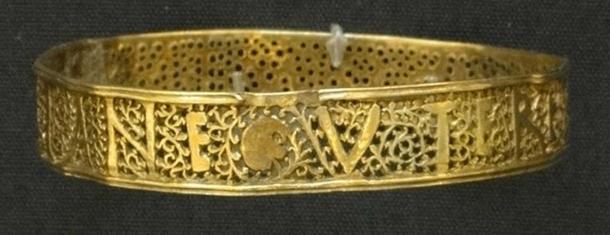
The Juliane Bracelet. (Fæ/CC BY SA 3.0)
It is reasonable to consider that Juliane and Aurelius were the couple who owned the treasure, and that the former was the woman depicted on the pepper pot. This, however, only remains a speculation, and we may never know for sure about the identity / identities of the hoard’s owner(s).
Top image: Three silver-gilt Roman piperatoria or pepper pots (CC BY NC SA 4.0), a gold body chain (Mike Peel/CC BY SA 4.0), toiletry items (Fæ/CC BY SA 3.0), two gold bracelets (Fæ/CC BY SA 3.0), and spoons (CC BY NC SA 4.0) found in the Hoxne hoard.
By: Wu Mingren
References
Aelius Stilo, 2018. Hoxne Hoard. [Online]
Available at: http://penelope.uchicago.edu/~grout/encyclopaedia_romana/britannia/saxonadvent/hoxne.html
Boissoneault, L., 2018. A Search for a Lost Hammer Led to the Largest Cache of Roman Treasure Ever Found in Britain. [Online]
Available at: https://www.smithsonianmag.com/history/search-lost-hammer-led-largest-cache-roman-treasure-ever-found-britain-180967263/
Current Archaeology, 2010. Hoxne Hoard. [Online]
Available at: https://www.archaeology.co.uk/articles/news/hoxne.htm
Hendrix, D., 2016. Hoxne Hoard. [Online]
Available at: http://www.thebyzantinelegacy.com/hoxne-hoard
The BBC, 2014. A History of the World in 100 Objects: Episode 40 - Hoxne Pepper Pot. [Online]
Available at: http://www.bbc.co.uk/ahistoryoftheworld/about/transcripts/episode40/
The British Museum, 2017. The Hoxne 'Empress' pepper pot / Hoxne. [Online]
Available at: http://www.britishmuseum.org/research/collection_online/collection_object_details.aspx?objectId=1362638&partId=1
www.hoxne.net, 2018. the hoxne hoard. [Online]
Available at: http://www.hoxne.net/history/hoard.html


















